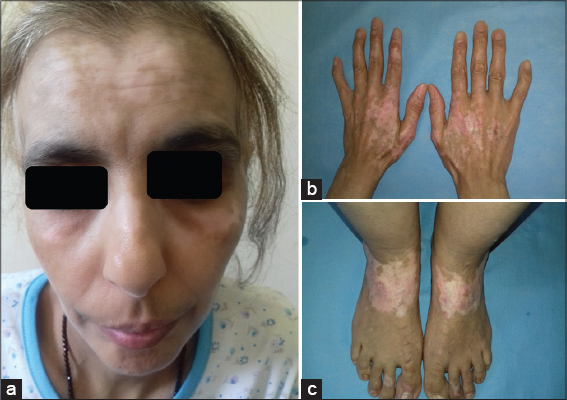Lupus erythematosus, thyroiditis, alopecia areata and vitiligo: A multiple autoimmune syndrome
Sara Dahhouki , Kaoutar Achehboune, Khadija Issoual, Zakia Douhi, Sara Elloudi, Hanane Baybay, Fatima Zahra Mernissi
, Kaoutar Achehboune, Khadija Issoual, Zakia Douhi, Sara Elloudi, Hanane Baybay, Fatima Zahra Mernissi
Dermatology Department, Hassan II Hospital University, Fez, Morocco
Corresponding author: Dr Sara Dahhouki
Submission: 03.05.2020; Acceptance: 05.06.2020
DOI: 10.7241/ourd.2020e.68
Cite this article: Dahhouki S, Achehboune K, Issoual K, Douhi Z, Elloudi S, Baybay H, Mernissi FZ. Lupus erythematosus, thyroiditis, alopecia areata and vitiligo: A multiple autoimmune syndrome. Our Dermatol Online. 2020;11(e):e68.1-e68.2.
Citation tools:
Copyright information
© Our Dermatology Online 2020. No commercial re-use. See rights and permissions. Published by Our Dermatology Online.
ABSTRACT
The combination of three autoimmune disorders or more in the same patient has defined as multiple autoimmune syndrome (MAS). As our knowledge, patients with autoimmune diseases have a tendency to develop additional autoimmune diseases. But the association of four autoimmune affections is rarely described. We report a case of a 32 year old woman with history of lupus, vitiligo and thyroiditis, presenting in our department with hair loss, which diagnosis of alopecia areata was made.
Key words:Lupus; Vitiligo; Alopeci areata; Thyroiditis; Autoimmune disease; Multiple autoimmune syndrome
INTRODUCTION
The association of three or more autoimmune diseases in a single patient has been defined as multiple autoimmune syndrome (MAS). However, the coexistence of three, four or even five autoimmune diseases is extremely rare (1). We report a case of this in a young patient.
CASE REPORT
A 32 year old woman, diagnosed with systemic lupus erythematosus 8 years earlier, put on topical corticosteroid, hydroxychloroquine and photo protection with good improvement, with vitiligo 6 years earlier, and an autoimmune thyroiditis 2 years earlier, which presented in our department for a hair loss of the scalp. The dermatological examination found diffuse non-scarring alopecia of the scalp; which dermoscopy objected a non-scarring alopecia, black dots (cadaverous hairs), yellow dots, tapering hairs (exclamation mark hairs), and broken hairs (Figs. 1a – 1f). Those lesions were diagnosis as alopecia areata. Moreover examination found limited hypopigmented macules with islands of repigmentation on the face, forearm and backs of hands, related to her vitiligo (Figs. 2a – 2c) and hyperpigmented scars patch related to previous lupus lesions. In light of these findings, multiple autoimmune syndrome (MAS) type 3, including lupus erythematosus, autoimmune thyroiditis, pelade and Vitiligo, was obtained.
DISCUSSION
Multiple autoimmune syndrome is the coexistence of three or more autoimmune disorders. It is further classified into MAS type 1, 2 and 3 [1]. Dermatological autoimmune diseases, especially vitiligo, have a crucial place [2]. To explain that, endocrine or dermatological auto immunities are associated with auto antibodies that react to specific antigens, while patients with collagen diseases synthesize immunoglobulins that recognize non-specific cellular receptors, such as nucleoproteins and nucleic acids. Cellular autoimmunity is important in pathogenesis of multiple autoimmune syndrome. Abnormalities of T-cell-mediated immunity and humoral immunity have been overlappingly implicated [2,3]. Disorders of autoimmune pathogenesis are more common in patients with a history of another autoimmune disease. At least, one of them is usually a skin disease, such as psoriasis or scleroderma [4]. Moreover, the coexistence of three, four or even five autoimmune diseases is extremely rare. The existence of an autoimmune disorder must contribute to discover other autoimmune diseases [5].
CONCLUSION
Although multiple autoimmune syndrome is rare, it should be considered if we have any autoimmune disease.
Consent
The examination of the patient was conducted according to the Declaration of Helsinki principles.
The authors certify that they have obtained all appropriate patient consent forms. In the form the patient(s) has/have given his/her/their consent for his/her/their images and other clinical information to be reported in the journal. The patients understand that their names and initials will not be published and due efforts will be made to conceal their identity, but anonymity cannot be guaranteed.
REFERENCES
1. Kechida M, Klii R, Hammami S, Khochtali I. Le syndrome auto-immun multiple Idans un service de médecine interne. Rev Méd Inter. 2016;37:A141–A267.
2. Tatu AL, Nwabudike LC. Lupus erythematosus, thyroiditis, alopecia areata and vitiligo – A multiple autoimmune syndrome type 3 case presentation. Our Dermatol Online. 2017;8:215-6.
3. Cherif Y, Ben Salah R, Frikha F, Dammak C, Jallouli M, Snoussi M, et al. Syndrome auto-immun multiple :àpropos de 17 observations. Rev Méd Inter. 2014;35:A142.
4. Harpreet S, Deepak J, Kiran B. Multiple autoimmune syndrome with celiac disease. Reumatologia. 2016;54:326–9.
5. Cojocaru M, Cojocaru I, Silosi I. Multiple autoimmune syndrome. Maedica (Buchar). 2010;5:132–4.
Notes
Source of Support: Nil,
Conflict of Interest: None declared.
Request permissions
If you wish to reuse any or all of this article please use the e-mail (brzezoo77@yahoo.com) to contact with publisher.
| Related Articles | Search Authors in |
|
 http://orcid.org/000-0003-3455-3810 http://orcid.org/000-0003-3455-3810 |





Comments are closed.